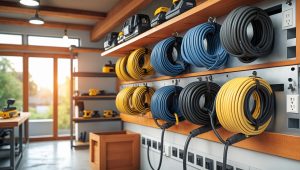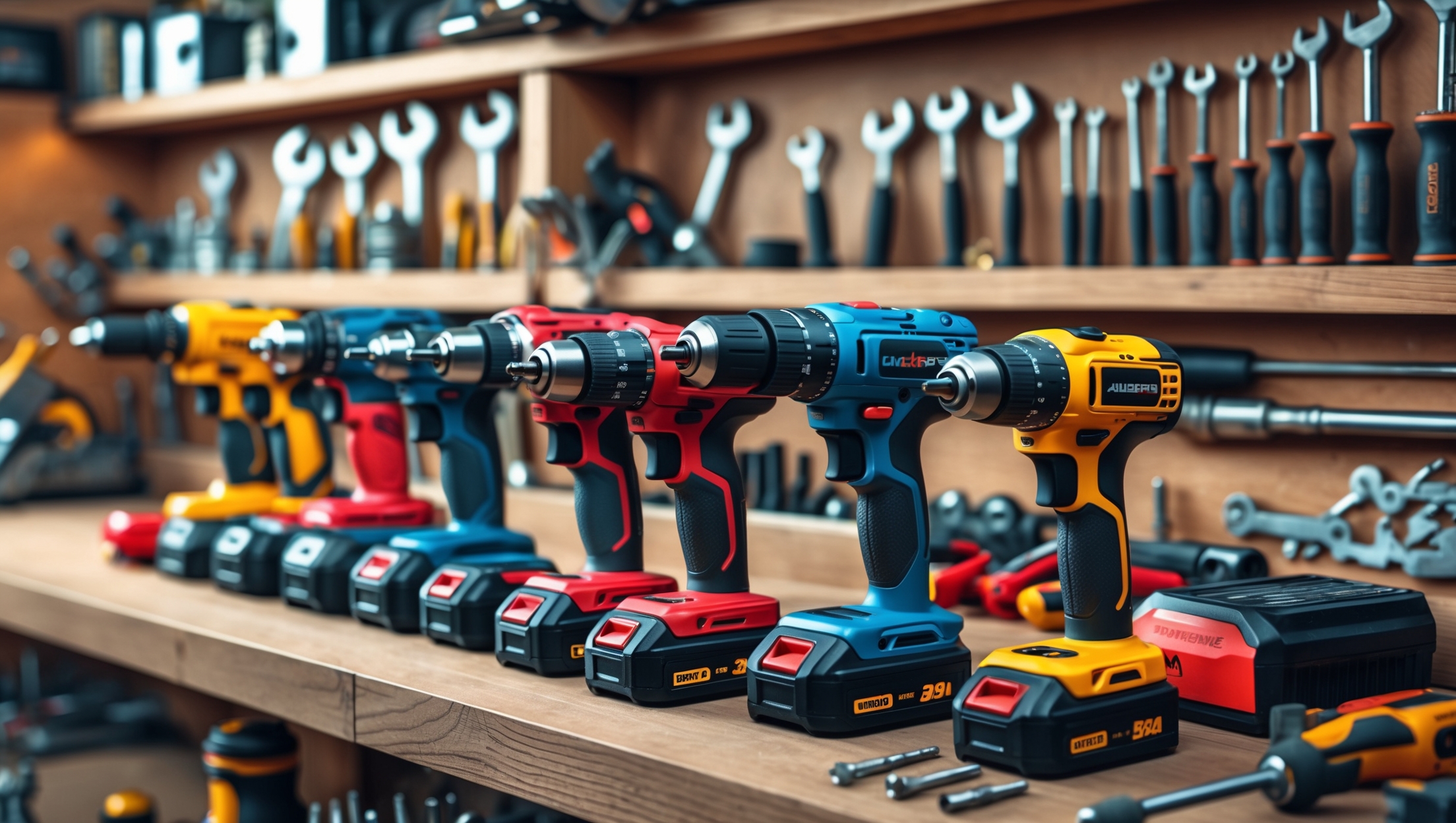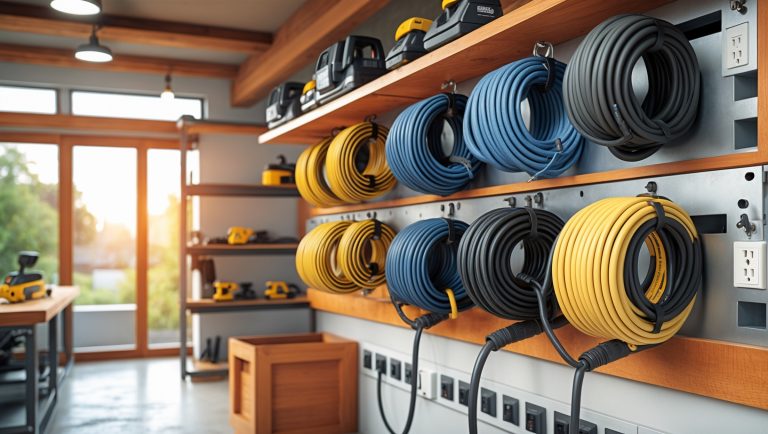Introduction: Why Cordless Drills Deserve a Deep Dive
Few tools have revolutionized home repairs, maintenance, and upgrades like the cordless drill. Whether you’re assembling flat-pack furniture, installing shelves, or tackling a major renovation, a reliable drill can make all the difference between a smooth project and a frustrating struggle. Yet, with countless models on the market—each boasting different torque ratings, battery technology, and smart features—choosing the right cordless drill isn’t as simple as grabbing the first deal you see. The wrong choice can mean underpowered performance, frequent battery swaps, or a tool that’s cumbersome for your needs. This guide is designed to cut through the clutter. We’ll compare key aspects such as torque output, battery life and type, ergonomic design, and essential (and optional) features. By the end, you’ll know exactly what to look for—whether you’re a weekend tinkerer or a committed DIYer ready to invest in a go-to workhorse for years to come.
Understanding Cordless Drill Basics: What Matters Most
Torque: The Power Behind the Drill
Torque, measured in Newton-meters (Nm), is the rotational force the drill applies to a screw or bit. Higher torque means the tool can drive larger fasteners or drill into tougher materials (like hardwood or masonry). Entry-level drills may offer 20–30 Nm, suitable for assembly and light repairs. Mid-range models often provide 40–60 Nm, covering most home needs. Heavy-duty models can exceed 70 Nm, ideal for demanding tasks such as deck construction or drilling large holes.
Battery Voltage: Not Just a Number
Drill batteries typically come in 12V, 18V/20V (often labeled interchangeably due to marketing), and 24V+ varieties. Higher voltage generally means more power and runtime, but also increased weight. For most homeowners, 18V/20V strikes the best balance between performance and portability. 12V models are ultra-compact and great for light tasks or tight spaces. Reserve 24V+ models for truly heavy-duty needs.
Battery Type: Lithium-Ion vs. Nickel-Cadmium
Modern drills almost exclusively use lithium-ion (Li-Ion) batteries, which are lighter, charge faster, and hold a charge longer than nickel-cadmium (NiCd) batteries. Li-Ion is a must for performance, longevity, and convenience. If you find a drill with NiCd batteries, consider it outdated unless you’re getting it for a rock-bottom price and light use only.
Comparing Popular Cordless Drill Models
To offer practical insight, here’s a side-by-side comparison of three leading cordless drills across entry, mid-range, and pro categories:
- Entry-Level: Black+Decker 20V MAX (LDX120C)
- Torque: 30 Nm
- Battery: 20V Li-Ion, 1.5 Ah
- Features: Lightweight (3.4 lbs), 11-position clutch, variable speed (0–650 RPM)
- Best for: Furniture assembly, light repairs, basic decor projects
- Mid-Range: DeWalt 20V MAX XR (DCD791D2)
- Torque: 70 Nm
- Battery: 20V Li-Ion, 2.0 Ah (two included)
- Features: Brushless motor, 15 clutch settings, compact design, LED light, belt clip
- Best for: Versatile home projects, woodworking, moderate construction tasks
- Pro-Grade: Milwaukee M18 FUEL (2803-22)
- Torque: 135 Nm
- Battery: 18V Li-Ion, 5.0 Ah (two included)
- Features: Brushless motor, all-metal chuck, 14 clutch settings, advanced overload protection
- Best for: Heavy-duty drilling, masonry, large builds, demanding renovations
Key Features to Evaluate in Cordless Drills
Clutch Settings and Speed Control
The clutch lets you adjust the torque output, preventing overdriving screws or damaging materials. More settings offer finer control, especially for varied tasks. Variable speed triggers allow you to start slow (for precision) and ramp up as needed.
Chuck Size and Type
Most home drills have a 3/8″ or 1/2″ keyless chuck—1/2″ accommodates larger bits for serious projects. Keyless chucks are standard; they let you swap bits quickly without extra tools.
Brushless vs. Brushed Motors
Brushless motors are more efficient, offer longer battery life, and require less maintenance than brushed motors. They’re found in mid-range and pro models and are worth the investment for frequent use.
Weight and Ergonomics
A heavy drill can cause fatigue during long sessions or overhead work. Look for balanced weight, rubberized grips, and compact designs if you anticipate extended use or need to work in tight quarters.
LED Work Light
Built-in LED lights illuminate dark corners, closets, or behind cabinets—an underrated feature that quickly becomes indispensable, especially for repairs in low-light spaces.
Belt Clip and Bit Storage
Built-in belt clips and onboard bit holders can speed up workflow and reduce lost bits during a job. While not essential, these small conveniences add up, especially for multi-room projects.
Battery Life: Real-World Performance
Capacity (Amp-Hours) Explained
Battery capacity, measured in amp-hours (Ah), determines how long the drill will run on a charge. Higher Ah means longer runtime, but also a heavier battery. For most homeowners, 2.0–3.0 Ah offers a good balance. If you plan on heavy use or long projects, consider 4.0–5.0 Ah batteries.
Charging Times and Backup Batteries
Fast chargers can reduce downtime between tasks, but it’s wise to have a second battery ready to swap in. Many mid- and high-end kits include two batteries for seamless work. Check for chargers with overcharge protection to extend battery life.
Interchangeability with Other Tools
Some brands use the same battery system across multiple tools (drills, saws, lights, etc.). Investing in a platform (e.g., DeWalt 20V MAX, Milwaukee M18) lets you expand your tool collection without buying extra batteries or chargers.
Practical Scenarios: Choosing the Right Drill for Your Needs
Scenario 1: Occasional DIYer (Basic Repairs, Assembly)
If you mainly hang pictures, assemble shelves, or need a drill a few times a month, a lightweight 12V or entry-level 18V model with a 1.5–2.0 Ah battery is ideal. Focus on comfort, simplicity, and price. Avoid heavy, feature-laden models that may be overkill.
Scenario 2: Regular DIYer (Upgrades, Moderate Construction)
For those who frequently undertake home upgrades—installing cabinets, building furniture, minor renovations—a mid-range 18V/20V drill with a brushless motor, multiple clutch settings, and at least two 2.0–3.0 Ah batteries will provide the right mix of power, runtime, and flexibility.
Scenario 3: Power User (Major Renovations, Outdoor Projects)
If you’re tackling deck builds, drilling into masonry, or want one drill to rule them all, opt for a pro-grade 18V+ or 24V model with high torque (100+ Nm), heavy-duty construction, and large-capacity batteries. Prioritize metal chucks, advanced overload protection, and robust warranties.
Tips for Getting the Most from Your Cordless Drill
- Buy Quality Bits: Even the best drill is only as good as its bits. Invest in a good set for wood, metal, and masonry.
- Store Batteries Properly: Keep batteries at moderate temperatures and partially charged if storing for long periods.
- Use the Clutch: Match the clutch setting to your material to avoid stripped screws and damaged workpieces.
- Clean Regularly: Dust and debris can clog vents and reduce lifespan. Wipe down your drill and clear the chuck after each use.
- Monitor Battery Health: If you notice reduced runtime, it may be time for a new battery. Lithium-ion packs degrade over time.
Feature Comparison Checklist: What to Look For
- Torque rating (Nm)
- Battery voltage and capacity (V, Ah)
- Brushless vs. brushed motor
- Number of clutch settings
- Chuck size and type
- Weight and ergonomics
- LED work light
- Included batteries and charger
- Platform compatibility (same batteries for other tools)
- Warranty length and terms
Common Myths About Cordless Drills Debunked
- Myth: Higher voltage always means better performance.
Reality: Torque, motor type, and build quality matter just as much. A well-designed 18V drill can outperform a poorly built 24V model. - Myth: All batteries are the same.
Reality: Battery chemistry, capacity, and quality vary. Stick with reputable brands and avoid generic replacements. - Myth: You need the most expensive drill for home use.
Reality: Match the tool to your needs. Most homeowners will never max out a pro-grade drill.
Maintenance: Keeping Your Drill in Top Shape
Battery Care
Charge batteries before they’re fully depleted, avoid extreme temperatures, and don’t leave them on the charger indefinitely. Clean contacts with a dry cloth for best performance.
Chuck and Motor Maintenance
Periodically open and close the chuck to prevent seizing, and clear any debris from vents. For brushless drills, maintenance is minimal; for brushed models, check brushes if the motor starts to spark or lose power.
Conclusion: Making the Right Choice for Years of Reliable Use
Choosing the perfect cordless drill is less about chasing the highest specs and more about understanding your home project needs. By focusing on torque, battery life, and practical features, you’ll avoid the common pitfalls of overspending or ending up with an underpowered tool. Remember to consider ergonomics for comfort, invest in quality bits, and stick with reputable brands that offer battery compatibility across multiple tools. Whether you’re an occasional fixer-upper or a seasoned DIY enthusiast, the right cordless drill will streamline your repairs, maintenance, and upgrades—saving you time, effort, and even money in the long run. Take the time to compare models, test grip and weight in-store if possible, and don’t be swayed by marketing hype. With this guide, you’re equipped to make an informed choice that’ll serve your home projects for years to come. Happy drilling!











When comparing torque ratings, how much should I prioritize higher torque for typical household projects like hanging shelves or assembling furniture? Would a mid-range 40–60 Nm drill be overkill for those jobs, or would it future-proof my purchase?
For most household projects like hanging shelves or assembling furniture, you don’t need maximum torque—a drill with 30–40 Nm is usually sufficient. However, choosing a mid-range 40–60 Nm drill isn’t overkill and can be a smart choice if you think you’ll tackle tougher tasks in the future, like drilling into masonry or working with hardwood. It gives you flexibility without being unnecessarily powerful for day-to-day needs.
When you mention that 18V/20V drills balance performance and portability for most homeowners, how big of a difference in actual runtime or power should I expect if I go for a 12V model for smaller tasks? Are there specific everyday jobs where a 12V is just not enough?
Choosing a 12V drill for small tasks like assembling furniture, hanging pictures, or light repairs usually works just fine, as these drills are compact and easy to handle. However, compared to 18V or 20V models, you’ll notice less power and shorter battery life—12V drills may struggle with drilling into dense materials (like hardwood or masonry) or driving large screws. For heavier jobs or longer sessions, the higher voltage models definitely have the edge.
You mention that 18V/20V drills offer a good balance between performance and portability for most homeowners. Are there any significant differences in battery life or weight between 18V and 20V models, or are they really just labeled differently for marketing?
The terms 18V and 20V are mostly marketing labels—both typically use the same battery cells, with 20V referring to the maximum voltage and 18V to the nominal voltage. In real-world use, there’s no significant difference in battery life or weight between them. Performance and runtime will depend more on the battery’s amp-hour rating and the drill’s overall design than on the 18V vs. 20V label.
When you talk about ergonomic design, do you have any specific features or brands you’d recommend for people who have smaller hands or might use the drill for long periods at a time?
For users with smaller hands or those planning to use a drill for extended periods, look for models with slim handles, lighter weight, and rubberized grips for comfort. Brands like Makita and Bosch often offer compact drills with these ergonomic features. Adjustable speed triggers and well-balanced designs can also help reduce fatigue during long projects.
I didn’t realize there’s a difference between battery voltage and torque. If I’m on a tight budget, is it better to focus on getting a drill with higher torque or a higher voltage battery, or do they usually go hand in hand?
Voltage and torque are related, but not the same. Voltage generally affects how much power the drill can deliver, while torque is about rotational force, which matters for tough jobs like driving large screws. If you’re on a budget, prioritize higher torque for most DIY tasks, since that will help with versatility. Many affordable drills offer decent torque without needing the highest voltage batteries.
When it comes to torque, how much overkill is too much for standard home tasks like assembling furniture or drilling into drywall? Would a 40–60 Nm model be overpowered for basic DIY projects?
A drill with 40–60 Nm of torque is definitely more powerful than you need for basic DIY tasks like assembling furniture or drilling into drywall. Most home projects only require about 20–30 Nm. Using a higher-torque drill isn’t dangerous, but it can make delicate work harder to control and may damage softer materials. For typical home use, a lighter model will be easier and more comfortable.
I noticed you pointed out that 12V drills are compact and good for tight spaces. Are there any big downsides to going with a 12V model for most home projects, or would an 18V be that much more versatile?
A 12V drill is lightweight and easy to handle, making it great for small projects and work in tight areas. However, its lower power can struggle with tougher jobs like drilling into masonry or driving long screws into hardwood. An 18V drill offers more power and versatility for heavier tasks, but it’s usually bulkier. If most of your projects are light-duty, a 12V should work well, but for more demanding jobs, an 18V is a safer bet.
I’m just getting into DIY projects and I’m not sure how much torque I actually need. If I’m mainly putting together furniture and maybe hanging shelves, would a 12V drill be enough, or should I go for the 18V/20V models mentioned here?
For assembling furniture and hanging shelves, a 12V drill should be more than enough. These drills are lighter and easier to handle for beginners, while still offering enough torque for common household tasks. You’d only need an 18V or 20V model if you plan to drill into masonry, thick wood, or take on larger renovation projects.
You mentioned that higher voltage usually means more power but also adds to the weight of the drill. For someone with smaller hands or less upper body strength, would it be better to sacrifice some voltage for comfort, or are there lighter high-voltage models available?
For users with smaller hands or less upper body strength, choosing a drill with lower voltage (like 12V or 14.4V) can be more comfortable and easier to handle, especially for most household tasks. While there are lighter high-voltage models on the market, they tend to be more expensive and may still feel heavier. Prioritizing ergonomics and weight over maximum power usually leads to a better experience for light to medium-duty projects.
You mentioned that battery type and torque are key features, but for a small business with multiple employees using the drill daily, what should I prioritize for longevity—higher voltage or a certain battery technology like lithium-ion?
For daily use in a small business, prioritize lithium-ion batteries over voltage alone. Lithium-ion batteries offer longer lifespan, lighter weight, and faster charging compared to older technologies like NiCd. While a higher voltage provides more power, quality lithium-ion packs in the 18V to 20V range typically deliver both performance and durability, making them ideal for frequent, demanding use.
I’m just getting into DIY projects and I’m confused about how much torque I really need for basic home tasks. If most of what I’m doing is assembling furniture and hanging shelves, would an entry-level drill with 20–30 Nm be enough, or should I consider something stronger?
For assembling furniture and hanging shelves, a drill with 20–30 Nm of torque is generally more than sufficient. Entry-level models in that range can easily handle wood screws and light-duty tasks. Only consider a higher torque drill if you plan to work with tougher materials or larger fasteners in the future.
If I mostly need a drill for light repairs and assembling furniture, would you recommend going with a 12V model for its compactness, or is it worth stepping up to 18V for better battery life and more flexibility down the road?
For light repairs and furniture assembly, a 12V drill is usually more than enough. They’re lighter, easier to handle, and still deliver enough power for most household tasks. If you think you might take on heavier projects in the future, an 18V model offers more versatility and longer battery life, but for your current needs, 12V should serve you very well.
I’m trying to decide between a compact 12V drill for small home repairs and an 18V for more general use. Besides the difference in torque and battery life mentioned here, are there any ergonomic trade-offs or features that might make one stand out for someone with smaller hands?
Compact 12V drills are usually lighter and have slimmer handles, which can be more comfortable and easier to grip for users with smaller hands. They also tend to cause less fatigue during extended use. In contrast, 18V drills are often bulkier and heavier, which might make them harder to control if your hands are small. Some 18V models do offer ergonomic grips and adjustable handles, so it’s worth trying both in person if possible.
You mention that higher voltage usually means more runtime but also increased weight. For someone who does longer DIY sessions, is it better to prioritize battery voltage for runtime or focus more on ergonomic design to reduce fatigue?
If you often work on longer DIY projects, it’s important to strike a balance. Higher voltage does offer more runtime, but the extra weight might cause fatigue over time. Consider a drill with mid-range voltage and a lightweight, ergonomic design. Many newer models offer efficient batteries without being too heavy, helping you work longer without discomfort.
The guide talks about weighing performance against portability and mentions battery types, but do specific brands have more reliable battery life or faster charging times? I’m trying to avoid getting stuck mid-project waiting for a recharge.
Different brands do vary in battery reliability and charging speed. Brands like DeWalt, Makita, and Milwaukee are known for long-lasting batteries and often offer fast chargers that can recharge batteries in under an hour. Entry-level brands might have shorter battery life and slower charging. Consider kits with two batteries, so you can keep working while the other charges.
You mention torque ranges for entry-level versus heavy-duty drills. Is it possible to overdo it on torque for typical DIY tasks, or could too much power actually damage delicate materials like drywall or soft wood?
Yes, using a drill with too much torque on delicate materials like drywall or soft wood can cause damage, such as stripping screws, splitting wood, or punching through surfaces. For most DIY tasks, an entry-level drill with adjustable torque settings is ideal. Always start with a lower torque setting and gradually increase it if needed to avoid damaging your materials.
With so many models featuring different smart options and battery types, what should I prioritize if my main concern is avoiding frequent battery swaps during longer projects? Are certain brands better for battery longevity?
If avoiding frequent battery swaps is your top priority, look for cordless drills with high-capacity batteries (measured in amp-hours, like 4.0Ah or higher) and efficient brushless motors, which consume less power. Some brands, like DeWalt, Milwaukee, and Makita, are known for long-lasting batteries and quick charging options. Also, consider kits that include a spare battery, so you can keep working while one charges.
Is there a certain feature or combination of specs you’d recommend for someone on a budget who still wants a cordless drill that won’t feel underpowered or need constant charging for weekend projects?
For a budget-friendly cordless drill that still performs well, look for one with at least 18V battery power and a lithium-ion battery, as these offer a good balance of torque and runtime. Variable speed settings and a keyless chuck are also helpful features. Aim for a model with two batteries included, so you can swap them out and avoid downtime during your weekend projects.
Could you clarify if there’s much of a difference in battery life between standard lithium-ion and some of the newer battery technologies? I hate it when my tools die halfway through a project and am wondering if paying extra for newer batteries is really noticeable for casual DIY jobs.
For most casual DIY tasks, standard lithium-ion batteries already provide solid battery life and are usually sufficient. Newer battery technologies, like advanced lithium polymer or high-capacity lithium-ion packs, can offer longer run times and faster charging, but the difference might not be very noticeable unless you do heavy-duty or extended projects. For occasional use, sticking with standard lithium-ion should be just fine and more cost-effective.